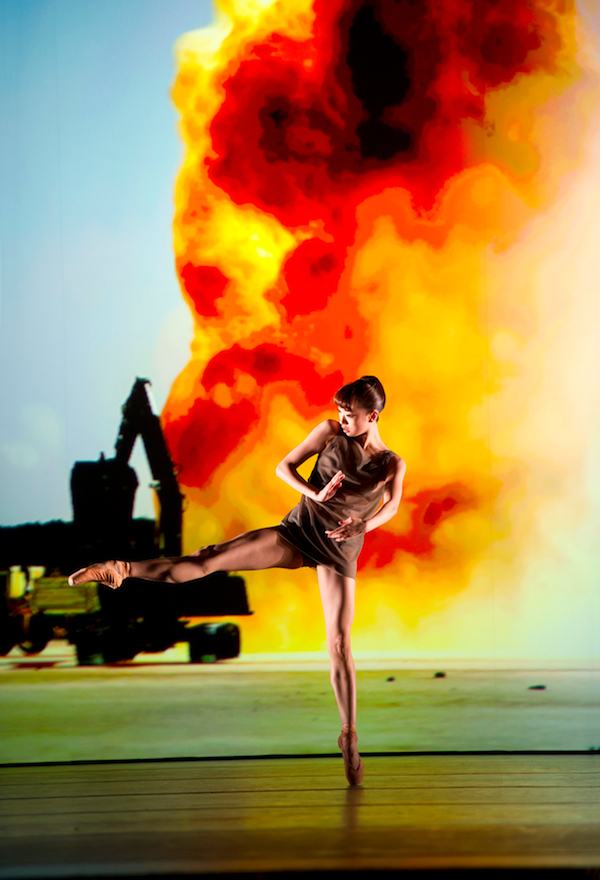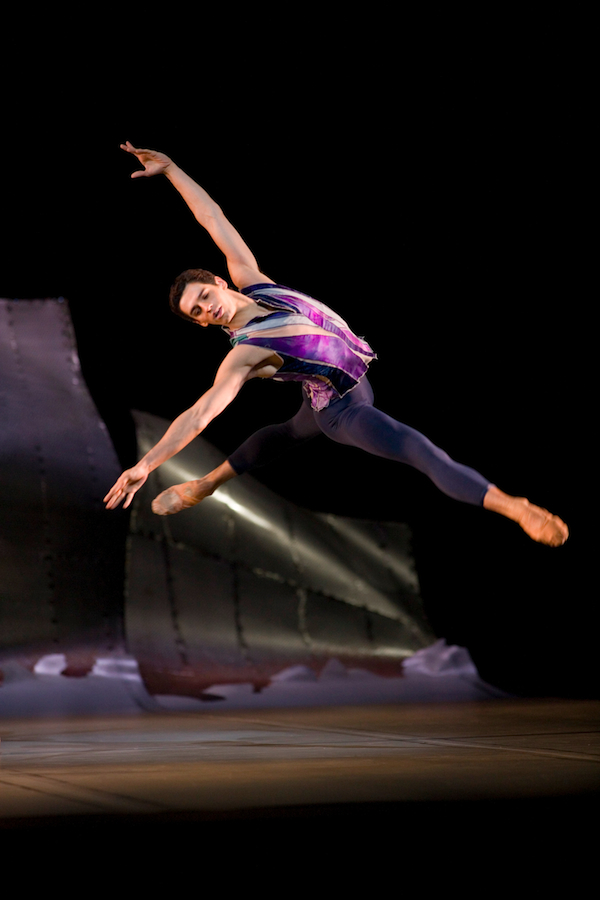Ballo Della Regina/ Live Fire Exercise/ DGV, Royal Ballet | reviews, news & interviews
Ballo Della Regina/ Live Fire Exercise/ DGV, Royal Ballet
Ballo Della Regina/ Live Fire Exercise/ DGV, Royal Ballet
Current events come too close for comfort in the new triple bill

Current affairs can be an on-trend choreographer's nemesis.
The evening’s success had to hang on the chiffon frivolity of the debut in the Royal Ballet of a bubbling, bravura ballerina work by Balanchine only 17 minutes long, which is little more than a virtuoso pas de deux with a lightweight corps attached. However, the lip-smacking success of last night’s show of Ballo della regina ("The Queen’s Ball") was down less to the leading ballerina than to the only man on stage - Sergei Polunin, unleashing his greyhound grace and majestic macho in leaps that politely defied gravity, while paying the kind of courtesy to the rabble of girlish pulchritude around him that makes a ballerina weak at the knees. In fact, perhaps Marianela Nuñez was weak at the knees, as she seemed so wreathed in smiles at him that she missed a few of the difficult roulades in the breathlessly nimble choreography. Ballo del re, more like.
With its giddy Verdi music and its effervescent brevity, Ballo should have been the merest bonne-bouche for the traditional yearly thrill of a new McGregor, always guaranteed to be weighty with portent and rich in theory. In Live Fire Exercise it is not physics or medical science that we are to sup in lengthy programme essays, but a stew of "radical", "complex" and "innovative" philosophical theories about war and ballet, and how McGregor's choreography means "multiple coordinations as a way of traumatising the body", though I'd hazard that it's the boys' toys of digital game visuals that really appealed here.
 War is understandably a preoccupation for creative artists just now - young Liam Scarlett used it obliquely and movingly in his elegiac ballet Asphodel Meadows a year ago but Live Fire Exercise makes it full-frontal without winning any belief in it as other than an image-making exercise. His six dancers in khaki underwear are busy, nervy, ant-like forms before John Gerrard’s huge video sequences of army trucks in the desert occasionally being blown up - they gust from side to side, they teeter and skitter, weightless avatars in a video game, in some other world from the consuming emotional urgency of Michael Tippett’s Fantasia Concertante on a Theme of Corelli which fills the house with plangent, trilling strings, driving past each other at different speeds, antique echoes, blurs, discords and asynchronicities mounting, only to collide periodically in marvellous romantic cadences.
War is understandably a preoccupation for creative artists just now - young Liam Scarlett used it obliquely and movingly in his elegiac ballet Asphodel Meadows a year ago but Live Fire Exercise makes it full-frontal without winning any belief in it as other than an image-making exercise. His six dancers in khaki underwear are busy, nervy, ant-like forms before John Gerrard’s huge video sequences of army trucks in the desert occasionally being blown up - they gust from side to side, they teeter and skitter, weightless avatars in a video game, in some other world from the consuming emotional urgency of Michael Tippett’s Fantasia Concertante on a Theme of Corelli which fills the house with plangent, trilling strings, driving past each other at different speeds, antique echoes, blurs, discords and asynchronicities mounting, only to collide periodically in marvellous romantic cadences.
In fact, the music is so overwhelming that the itchy-scratchy dance calligraphy in half-dark makes no impact on it, for all the efforts of Akane Takada and Ricardo Cervera in particular to imprint some kind of personality on their expertly minced, chopped and broken movements. (Takada pictured right © Bill Cooper.) Possibly Gerrard is complementing McGregor’s mission of enlightenment with his virtual-reality images. But then again, possibly this is just an eye-catching cliché being pushed into position, so that the effortless dance scribbling can simply resume where it stopped in the previous radical, complex, innovative new McGregor piece.
After McGregor’s busy-busyness, Wheeldon’s slick 2006 DGV: Danse à grande vitesse feels like a sibling of exactly the same family: the visual image not trucks but trains, the dancers not six nervy avatars but eight elusive time-travellers whose dance-shapes wisp, curl and bobble. The set is a picturesque wreck of steel, with a great sharp light over it, and again there is an overbalancing score, this time negatively, in Michael Nyman’s repetitious, chugging wallpaper music, MGV, written for the inauguration of a new French TGV. The name’s much the wittiest thing about it.
 Wheeldon uses a stretched and pliant line that contrasts not uninterestingly with McGregor’s phased, blippy fragments, both of them good students of late Eighties William Forsythe. Wheeldon, though, seems to understand the graphic dimensions of partnering better (a throwback to his Balanchine apprenticeship with the New York City Ballet, surely), and marshals his four couples and 18 supporting dancers in stronger formation effect. (Federico Bonelli pictured left © Johan Persson/ROH.)
Wheeldon uses a stretched and pliant line that contrasts not uninterestingly with McGregor’s phased, blippy fragments, both of them good students of late Eighties William Forsythe. Wheeldon, though, seems to understand the graphic dimensions of partnering better (a throwback to his Balanchine apprenticeship with the New York City Ballet, surely), and marshals his four couples and 18 supporting dancers in stronger formation effect. (Federico Bonelli pictured left © Johan Persson/ROH.)
Zenaida Yanowsky looks magnificent in this kind of work, statuesque and bronzed, and she’s given eloquent support by Eric Underwood. Still better, though, are Gary Avis and the classy Melissa Hamilton (in Darcey Bussell’s original role), with Avis effortlessly bearing Hamilton aloft with the instinctive fastidiousness of a porter carrying an ostrich-skin valise to the luggage rack. There is possibly the faintest smile towards Jerome Robbins’s The Concert, but overall DGV is a great concept and set (Jean-Marc Puissant), running on dreary musical rails along which the choreographic train doesn’t go very far. Nor does the evening, as dance. But hats off to the Royal Opera House orchestra, handling the Verdi, Tippett and Nyman with equal respect - that's professionalism.
- The Royal Ballet's triple bill of Balanchine, McGregor and Wheeldon has performances until 25 May
- See what's on at the Royal Ballet. Read Royal Ballet reviews
- John Gerrard’s visual motion-capture installation Infinite Freedom Exercise (near Abadan, Iran), 2011 is showing at the Manchester International Festival in Lincoln Square, Manchester, 5-17 July
Watch Merrill Ashley discuss and coach Ballo della regina with the Royal Ballet
Explore topics
Share this article
Add comment
The future of Arts Journalism
You can stop theartsdesk.com closing!
We urgently need financing to survive. Our fundraising drive has thus far raised £49,000 but we need to reach £100,000 or we will be forced to close. Please contribute here: https://gofund.me/c3f6033d
And if you can forward this information to anyone who might assist, we’d be grateful.

Subscribe to theartsdesk.com
Thank you for continuing to read our work on theartsdesk.com. For unlimited access to every article in its entirety, including our archive of more than 15,000 pieces, we're asking for £5 per month or £40 per year. We feel it's a very good deal, and hope you do too.
To take a subscription now simply click here.
And if you're looking for that extra gift for a friend or family member, why not treat them to a theartsdesk.com gift subscription?
more Dance
 'We are bowled over!' Thank you for your messages of love and support
Much-appreciated words of commendation from readers and the cultural community
'We are bowled over!' Thank you for your messages of love and support
Much-appreciated words of commendation from readers and the cultural community
 Peaky Blinders: The Redemption of Thomas Shelby, Rambert, Sadler's Wells review - exciting dancing, if you can see it
Six TV series reduced to 100 minutes' dance time doesn't quite compute
Peaky Blinders: The Redemption of Thomas Shelby, Rambert, Sadler's Wells review - exciting dancing, if you can see it
Six TV series reduced to 100 minutes' dance time doesn't quite compute
 Giselle, National Ballet of Japan review - return of a classic, refreshed and impeccably danced
First visit by Miyako Yoshida's company leaves you wanting more
Giselle, National Ballet of Japan review - return of a classic, refreshed and impeccably danced
First visit by Miyako Yoshida's company leaves you wanting more
 Quadrophenia, Sadler's Wells review - missed opportunity to give new stage life to a Who classic
The brilliant cast need a tighter score and a stronger narrative
Quadrophenia, Sadler's Wells review - missed opportunity to give new stage life to a Who classic
The brilliant cast need a tighter score and a stronger narrative
 The Midnight Bell, Sadler's Wells review - a first reprise for one of Matthew Bourne's most compelling shows to date
The after-hours lives of the sad and lonely are drawn with compassion, originality and skill
The Midnight Bell, Sadler's Wells review - a first reprise for one of Matthew Bourne's most compelling shows to date
The after-hours lives of the sad and lonely are drawn with compassion, originality and skill
 Ballet to Broadway: Wheeldon Works, Royal Ballet review - the impressive range and reach of Christopher Wheeldon's craft
The title says it: as dancemaker, as creative magnet, the man clearly works his socks off
Ballet to Broadway: Wheeldon Works, Royal Ballet review - the impressive range and reach of Christopher Wheeldon's craft
The title says it: as dancemaker, as creative magnet, the man clearly works his socks off
 The Forsythe Programme, English National Ballet review - brains, beauty and bravura
Once again the veteran choreographer and maverick William Forsythe raises ENB's game
The Forsythe Programme, English National Ballet review - brains, beauty and bravura
Once again the veteran choreographer and maverick William Forsythe raises ENB's game
 Sad Book, Hackney Empire review - What we feel, what we show, and the many ways we deal with sadness
A book about navigating grief feeds into unusual and compelling dance theatre
Sad Book, Hackney Empire review - What we feel, what we show, and the many ways we deal with sadness
A book about navigating grief feeds into unusual and compelling dance theatre
 Balanchine: Three Signature Works, Royal Ballet review - exuberant, joyful, exhilarating
A triumphant triple bill
Balanchine: Three Signature Works, Royal Ballet review - exuberant, joyful, exhilarating
A triumphant triple bill
 Romeo and Juliet, Royal Ballet review - Shakespeare without the words, with music to die for
Kenneth MacMillan's first and best-loved masterpiece turns 60
Romeo and Juliet, Royal Ballet review - Shakespeare without the words, with music to die for
Kenneth MacMillan's first and best-loved masterpiece turns 60
 Help to give theartsdesk a future!
Support our GoFundMe appeal
Help to give theartsdesk a future!
Support our GoFundMe appeal

Comments
...
...